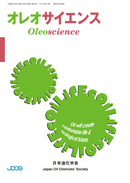
- |<
- <
- 1
- >
- >|
-
Tomohiro ASAI, Takehisa DEWA, Naoto OKU2016Volume 16Issue 6 Pages 271-278
Published: 2016
Released on J-STAGE: February 01, 2019
JOURNAL FREE ACCESSRNA interference (RNAi) effectors such as small interfering RNA (siRNA) and microRNA (miRNA) are promising drug candidates because of their selectivity, potency, and versatility. For the development of RNAi therapeutics, a practical delivery system is required to deliver siRNA to target cells because RNA is easily degraded by RNases and hardly internalized into the cells. Development of the delivery system is the most urgent and crucial thing for clinical use of RNAi effectors. In this review, we first discuss our current understanding of the challenges for the development of RNAi therapeutics and then focus on our recent progress in engineering lipid nanoparticles (LNP) loaded with siRNA. In our recent studies, we synthesized various types of polycationic lipid derivatives, used them to prepare LNP, and demonstrated their high potential for siRNA delivery. Peptide-modified LNP carrying cholesterol-grafted siRNA were designed for systemic targeted delivery and examined their biodistribution and therapeutic efficacy in tumor-bearing mice. Our results showed that peptide-modified LNP loaded with siRNA targeting mammalian target of rapamycin (mTOR) were selectively delivered to the tumor and significantly suppressed tumor growth. The present findings suggest that our LNP is useful for systemic targeted delivery of siRNA.
View full abstractDownload PDF (1385K) -
Yasuko OBATA, Kozo TAKAYAMA2016Volume 16Issue 6 Pages 279-284
Published: 2016
Released on J-STAGE: February 01, 2019
JOURNAL FREE ACCESSStratum corneum, outermost layer of skin, maintains physical barrier to prevent dehydration and invasion of substances. Stratum ocnruem sometimes expressed as “brick-mortal” model. Ke ratinocyte corresponds to “brick” and intercellular space corresponds to “mortal”. Intercellular space is filled by lipids, such as ceramides, cholesterol and free fatty acids. Those lipids form regular arrangement, so called “lamellar structure”. There are two kinds of lamellar structure of intercellular lipids determined by synchrotron X-ray diffraction. The periodicity of long lamellar structure is about 13 nm and that of short lamellar structure is about 6 nm. The lateral packing of lamellar structure is known as orthorhombic and hexagonal packing. There exists several phase transition of intercellular lipids such as liquidization of orthorhombic packing, formation and liquidization of high-temperature hexagonal packing and liquidization of long and short lamellar. Those phase transition was affected by the administration of components of topical and transdermal formulation. Change in thermotropic behavior of intercellular lipids might be a key factor of promoting activity of skin permeation enhancement of topical and transdermal formulation. To develop effective formulation, observation of change in structure and phase transition is important to evaluate formulation components.
View full abstractDownload PDF (1112K) -
Kazuo MARUYAMA2016Volume 16Issue 6 Pages 285-291
Published: 2016
Released on J-STAGE: February 01, 2019
JOURNAL FREE ACCESS“Theranostics” is a portmanteau word of therapeutics and diagnostics. The term “Theranostics” describes technology with concurrent and complementary diagnostic and therapeutic capabilities. Among all diagnostic imaging techniques, ultrasound imaging has a unique advantage because it is real-time, low-cost, safe, and easy to incorporate into portable devices. We recently developed intelligent lipid bubbles called “Bubble liposomes” (BLs) based on liposome technology. BLs contain echo contrast gas, which can function as an ultrasound imaging and delivery tool for drug and gene with ultrasound exposure in vitro and in vivo. Combination of BLs and ultrasound can use for the neovasuculature opening in solid tumor and thrombolysis. Here we describe about the ultrasound theranostics using a combination method with BLs and ultrasound.
View full abstractDownload PDF (1573K) -
Hirokazu OKAMOTO2016Volume 16Issue 6 Pages 293-301
Published: 2016
Released on J-STAGE: February 01, 2019
JOURNAL FREE ACCESSWe prepared dry gene powders for inhalation by several techniques. The chitosaninterferon-β gene complex powder prepared in supercritical CO2 was effective to suppress the growth of murine lung metastasis. Next we prepared luciferase gene powders with PAsp(DET) or PEG-PAsp(DET) as a vector by spray-freeze-drying technique. The powder with PAsp(DET) and L-leucine as a dispersant reagent had 50 times higher gene expression efficiency than that with chitosan. It was suggested that optimization of vector and additive maximized gene expression by powder formulations for inhalation.
View full abstractDownload PDF (2695K)
- |<
- <
- 1
- >
- >|